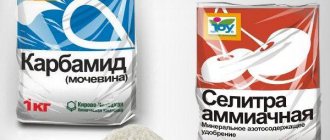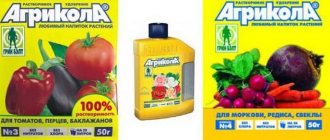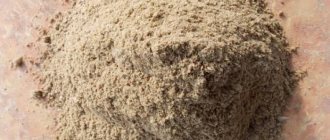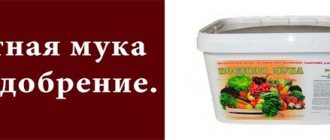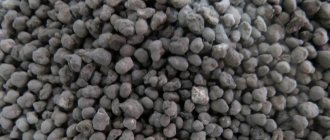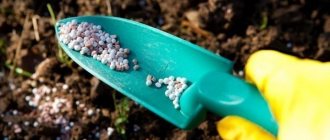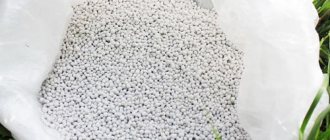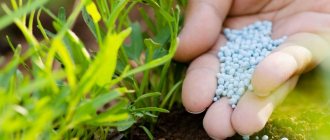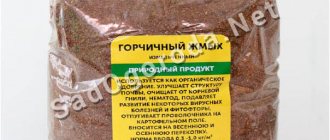Category: Mineral fertilizers Reading time: 8 min · Views: 2,461
Calcium nitrate (calcium nitrate, calcium nitrate) is often used as a fertilizer for any type of soil. Calcium nitrate quickly dissolves in water and is available in the form of crystalline structures or granules. Fertilizer increases the yield of fruit and vegetable crops without adversely affecting human health. Saltpeter is also used to fertilize flower beds and shrubs.
Composition and formula of calcium nitrate
The alkaline preparation dissolves quickly in water. The product has a chemical formula: Ca (NO3)2. The composition of calcium nitrate includes (in%):
- calcium – 19;
- nitrogen – from 13 to 16.
Calcium nitrate almost does not acidify the soil, therefore it shows excellent results in soddy-podzolic areas. The active substances neutralize the acid and draw out excess components (iron, manganese) from the top layer. Nitrate fertilizer works well on any soil and in all climatic conditions. Fertilizing supports plants in dry areas.
Properties
Many gardeners often neglect the use of calcium nitrate when fertilizing their plots. Yes, calcium is not part of the NPK complex, which includes vital substances. But, at the same time, it is calcium that helps to fully absorb nitrogen, the main substance from NPK - a complex that ensures the active growth and development of all plants.
A very important property of calcium nitrate is that it is considered the best fertilizer for acidic soils. This fat has a revitalizing effect on plants, promoting their high-quality vegetation, as it absorbs from the soil excess manganese and iron, metals that are found in large quantities in acidified soils.
Lack of calcium primarily affects the root system. She stops receiving the required amount of nutrients. The local balance is disrupted, the roots stop absorbing the moisture supplied to them and rot. After this happens, the entire plant may die. To avoid negative consequences, it is necessary to apply this fertilizer in a timely manner.
The instructions for use, which come with fertilizers containing calcium nitrate, say that they must be applied in the spring, before digging the soil. In the fall, it is absolutely not worth using this fertilizer, since all the nitrogen contained in it will be washed away during snowmelt, and all that will remain from a balanced complex of useful elements is calcium, which without nitrogen is not very useful, and most often is simply harmful.
In the last few years, calcium nitrate has been produced in two forms - granular and crystalline. Since the crystals of this salt are highly hygroscopic, if you have a choice, it is better to purchase a granular form, which is much more convenient to handle, does not generate dust during application, and absorbs less moisture from the surrounding air.
Types of the drug
Calcium nitrate comes in two forms: white granules and a translucent crystalline salt. The popular product is produced by different people, aimed at medium and large farms, and packages products in one-kilogram bags. The Buyskie Fertilizers brand offers three types of packaging:
- 20 g;
- 25 g;
- 1 kg.
Manufacturers indicate a warranty shelf life of 2 years. The granules practically do not absorb moisture. The chemical in the package does not cake and does not lose its original characteristics over time. Crystals blur and become damp, so they should only be kept in a sealed bag or in a dry room.
How to add the supplement?
Fertilizer can be applied in dry or dissolved form. In the second case, spraying of plants, root and drip watering is allowed.
Calcium nitrate (calcium nitrate) is a water-soluble fertilizer.
Let's look at each technique:
- Dry.
Powder or granules are evenly distributed over the area in early spring. Then you need to dig up the soil; watering is not necessary.
Do you use folk signs in gardening?
In late autumn, calcium nitrate is not applied. Since during winter and spring nitrogen will be washed out of the soil, and calcium without it is not of particular value. Moreover, its excess can harm crops.
On acidic soils, bait can be applied during planting of seedlings or seeds. Consumption rate: 1 teaspoon per hole or 1 tablespoon per 1 bed 50 cm long.
- Spraying.
The procedure must be carried out before the crops bloom. The ideal time is when the first leaves appear on the plants. This technique is suitable for berry bushes, vegetables, and fruit trees.
The bait concentration is 25 g of calcium nitrate per 1 liter of clean water.
But the fertilizer consumption for crops will be different:
- for decorative shrubs (deciduous and coniferous) – 1 liter per bush;
- for berry bushes (raspberries, blackberries, currants, blueberries) – 1.5 liters per bush;
- for fruit trees, consumption will vary between 3-8 liters, the volume depends on the age and size of the tree;
- berry crops and vegetables are sprayed with 8 liters of solution on the basis that this volume will be used to treat 10 square meters.
Preparing soil with calcium nitrate
The use of calcium fertilizers for tomatoes eliminates the risk of late blight and root rot. The fruits become juicy and tolerate transportation well.
- Under root watering.
Calcium nitrate dissolves very well in water, both in the form of powder and granules. It can be applied by watering the roots several times a season, but before active fruiting.
The consumption rate for crops is:
- berries (strawberries, raspberries, wild strawberries) – 25 g per 8-15 liters of water;
- vegetables (tomatoes, peppers, eggplants, cucumbers) – 25 g per 10-15 liters of water;
- shrubs – 25 g per 8 liters of water;
- trees - 25 g per 10 liters of water.
Intervals between treatments should be at least 10 days.
According to the instructions for use, calcium nitrate can be combined with insecticides, pesticides and other fertilizers. The exception is bait containing phosphorus and sulfur.
Beneficial properties for plants
Nitrate or calcium nitrate increases yields by 15% in many garden and fruit crops. With the correct dosage, substances do not accumulate or transform into dangerous compounds. Mineral fertilizer has a positive effect on plants:
- Immunity increases: strengthens cell membranes, improves resistance to temperature changes, diseases and pests. Root and blossom end rots are less likely to affect tomatoes and peppers, while clubroot is less likely to affect cabbage and radishes.
- Photosynthesis accelerates. The substance promotes the development and growth of roots and foliage.
- Stimulates awakening: treated seeds, tubers and bulbs hatch faster.
- Improves soil quality. Neutralizes acidity in the soil, absorbs metals, and prevents the formation of dangerous chemical compounds.
- Positively affects product characteristics. As a result of the use of agricultural products, the sugar content of vegetables and fruits increases, and their taste changes in a positive direction. The harvest ripens faster and the shelf life of the product is extended.
Growing strong crops in the garden
Let's consider the positive effects of using calcium nitrate for the most common garden crops.
Complex mineral fertilizer Calcium nitrate, 1kg, TM ROSLA (Rosla)
- Cabbage.
Not many summer residents can boast of a harvest of really good cabbage with large heads. This crop is valued for its juiciness and long-term storage. Cabbage often does not grow in acidic soils, however, if you fertilize the soil and holes with calcium nitrate before planting, you can get a good harvest.
This vegetable can be fed with fertilizer in different ways. The consumption rate of the drug is 1 g per 1 liter of water.
- Tomatoes.
Ripe early tomatoes with juicy pulp that are stored for a long time are an achievement of competent fertilizing of the soil with saltpeter. Fertilize them before flowering by root watering or spraying.
Calcium nitrate will protect tomatoes from blossom end rot, thrips, slugs and other pests. You need to fertilize the soil before planting the plants in the soil and after 2 weeks. Nitrate will stimulate the development of the root system and green mass of plants.
The main rule of processing is that there is no need to feed bait when the fruit is already set. After all, fruits, vegetables and berries can accumulate nitrates.
Advantages and disadvantages of the drug
Plants do not absorb nitrogen well in acidic soil. Urea and ammonium nitrate increase the acidity of the area. Calcium nitrate, on the contrary, promotes alkalization of the soil and has a complex effect, so the benefits of use are noticeable after 2-3 weeks. Beneficial bacteria actively develop in the soil, which improve its structure. The product neutralizes the entry of harmful salts and metals into planting tissue.
Exceeding the dosage of the drug or incorrectly chosen timing of treatment can lead to negative reactions. Excess fertilizer destroys roots and tops. The underground parts stop absorbing water and nutrients. The incoming liquid provokes the appearance of rot.
Nitrogen and calcium fertilizers
The importance of nitrogen fertilizers for garden crops is difficult to overestimate - nitrogen is included in the structure of plant protein. Nitrogen deficiency leads to the fading of the growth and development of seedlings, to their premature withering and death. Nitrogen is involved in the process of photosynthesis, without which the crop cannot grow and form leaves. The most nitrogen is contained in chernozems, the minimum percentage is in sandstones.
Signs of nitrogen deficiency:
- the leaves of the plants become smaller, turn yellow and wither;
- the green area becomes rare;
- the fruit ovary dries and falls off;
- the plant stops growing;
- young shoots do not appear.
These signs indicate a lack of nitrogen in the soil. This means it’s time to add calcium nitrate.
With nitrogen starvation, cabbage leaves become transparent and turn yellow. With severe nitrogen deficiency, the leaves do not curl up and turn red. Tomato leaves take on a pale green tint, with reddish veins visible on the back side.
Nitrogen deficiency in cucumbers leads to weakening of the stem, yellowing of the leaves and lack of fruit set. In beets, the leaves take on a pale yellow appearance and quickly wither. Bell peppers and eggplants produce yellow leaves that are ready to fall off at any moment. In fruit trees, nitrogen starvation is expressed in yellowing of the leaves of the lower branches.
An excess of nitrogen is also harmful to plants and they may die. An overabundance will be indicated by too juicy foliage, small fruits and a weak structure of the ovaries. In this case, calcium nitrate cannot be added.
Nitrogen fertilizer is combined with calcium, which helps it be absorbed by plants. Calcium plays an equally important role in the health of plants and fruits. The strong and correct formation of the root system, the flow of vital processes and the taste of ripened fruits depend on it. Calcium ions ensure the absorption of nitrogen from the soil.
Note! Calcium plays an important role in the formation of juicy and tasty fruits.
Thanks to calcium, the fruits form a strong peel, which helps protect against pests and gray rot. Calcium also strengthens the stalk, which firmly holds the ripe fruit on the tree, and ensures intracellular fluid exchange.
Diseases caused by calcium deficiency:
- bitter rot in apples;
- premature spoilage of fruits;
- cracking and small fruit;
- sunburn.
Note! It is not recommended to combine calcium fertilizers with the use of straw, sawdust and peat.
It is not recommended to exceed the dosage of calcium fertilizers, since they are nitrate and can accumulate in fruits.
Let us consider in detail the composition and use of calcium nitrate - calcium nitrate.
Features of use on a personal plot
It is important to use calcium nitrate fertilizer according to the rules. The product is not universal; there are restrictions on application periods and soil requirements. If you follow the instructions, you can easily avoid mistakes.
The need for fertilizing of various crops
Not all plants respond equally positively to the application of calcium nitrate. It is prohibited to feed species that develop in acidic soil:
- marsh berries (lingonberries, blueberries, cranberries);
- conifers;
- heather;
- azaleas;
- ferns;
- hydrangeas.
Crops that prefer slightly acidified soil may die from calcium nitrate. Regular fertilization is contraindicated:
- chamomile;
- decorative maple;
- acacia;
- barberry;
- honeysuckle;
- viburnum
In horticulture, stone fruit trees, grapes and apple trees are responsive to applications. To prevent strawberries and wild strawberries from becoming smaller, you need to feed them with calcium nitrate. Gladioli and spring bulbous species love the popular fertilizer. You will be pleased with abundant flowering:
- clematis;
- phlox;
- dahlias;
- lilies.
Fertilizing is required for all pumpkin and nightshade crops.
A balanced composition has a positive effect on the formation of heads in cabbage and pods in legumes. In a fertilized garden, herbs, onions and garlic develop faster than in a regular plot.
The use of calcium nitrate on different types of soil
Immediately after picking, tomato seedlings need to be fertilized with calcium nitrate.
Calcium nitrate is essentially an alkaline fertilizer. The cardinal difference from most nitrogen-containing fertilizers is that it does not acidify the soil. This feature allows the use of calcium nitrate on all types of soil, especially acidic ones. Calcium neutralizes excess iron, manganese, zinc, and other metals that accumulate excessively in acidified soil. The most pronounced effect is observed on sandy, sandy loam, soddy-podzolic lands and solonetzes. On light sandy loam soils, agronomists recommend applying this fertilizer little by little but often. Heavy clay soils and loams, on the contrary, should be fertilized with saltpeter less frequently.
Calcium nitrate is suitable primarily for soils in the non-chernozem zone, where there is a lack of calcium. It is advisable to alternate the application of ammonium sulfate (see → how to apply fertilizer + reviews), as the main nitrogen fertilizer, with calcium nitrate. Calcium nitrate, even if applied frequently and abundantly, does not impair the physical properties of the soil. On the contrary, there is an improvement in the structure of podzolic soils. This factor positively distinguishes calcium nitrate from ammonium and sodium nitrate.
Agrochemist, biochemist, academician. D. N. Pryanishnikov.
It should be borne in mind that calcium deficiency is aggravated by prolonged heat and drought. In extreme temperature conditions, roots suffer and lose their ability to absorb moisture. Calcium nitrate revives the growing season and guarantees normal plant growth.
Instructions for use
For calcium nitrate to be beneficial, the granules must be properly diluted. The norms depend on the type and age of the plants. This fertilizer, applied according to the instructions, will protect plants from diseases and take care of their immunity.
To avoid burning the roots, be sure to water the garden bed before the procedure.
For seedlings
Nitrogen and calcium help produce strong, healthy seedlings. The first application is carried out after the formation of the third adult leaf, the second - 10 days after the dive. Carefully irrigate at the root, trying not to get on the tops. For 5 liters of water take (in g):
- calcium nitrate – 10;
- urea – 5;
- wood ash – 50.
For cucumbers
Cucumbers develop underground parts slowly, so application must be carried out carefully. After three adult leaves appear, the seedlings are sprayed with calcium nitrate. Root feeding is repeated every 8 days until fruit sets. In order not to make a mistake with the dose, you need to dilute 2 g of the product in 1 liter of water.
Calcium nitrate and cucumbers
Cucumbers respond well to additional doses of calcium and nitrogen. Especially during the period of green mass growth.
Calcium nitrate is first applied to cucumbers at the third leaf growth stage. Then every 10 days , alternating root and foliar feeding.
Application rates:
- in the form of a solution – 10 g per 10 liters of water ;
- for leaf feeding - 20 g per 10 l .
It is beneficial to germinate seeds in fertilized soil. Calcium activates enzyme activity, so seeds germinate better and faster.
Spring frosts in unstable temperature regions can destroy young cucumber seedlings, so calcium nitrate is more often used in cold climates.
After treatment with the solution, plants recover faster and continue to gain strength. The above-ground part is not damaged, and the roots do not rot from frost.
Video: How to use fertilizer
DIY calcium nitrate
If fertilizer is not on hand, you can prepare the preparation at home. In the fresh air, they build a structure of bricks and light a fire. In an aluminum pan combine:
- water - 500 ml;
- slaked lime – 140 g;
- ammonium nitrate – 300 g.
The mixture is heated until the specific ammonia smell disappears. The fire is extinguished and the product is left to cool. For applications, use clean upper liquid, and the dark lower layer is removed.
Mineral fertilizers help gardeners and gardeners grow a bountiful harvest and get beautiful flowers. Understanding when and why calcium nitrate is used, you don’t have to worry about whether feeding a particular crop is suitable or not. If you use a high concentration, the solution will destroy the protective coating of the roots and foliage.
Answers on questions
Question No. 1. Is it possible to determine by external signs whether a plant needs feeding with calcium, namely calcium nitrate?
Signs of calcium deficiency appear primarily on young shoots. New leaves turn brown and die. Calcium deficiency can be judged by a number of other signs:
- curling the edges of the sheet upward;
- irregular shape of the leaf blade;
- the formation of whitish stripes and a white border on young leaves;
- damage and death of apical buds;
- hypertrophied branching of roots.
Question No. 2. Are there any restrictions on the types of crops when using calcium nitrate as a fertilizer? (click to expand)
Calcium nitrate does not need to be applied to crops that prefer high soil acidity:
- viburnum, honeysuckle;
- ferns, conifers;
- rhododendron, lupine, azalea;
- blueberries, garden strawberries.
Foliar fertilizing with saltpeter for potatoes is not recommended. Excess fertilizer can cause the tops to be excessively tall and the tubers to be underdeveloped or unsuitable for food.
Dosage standards
Calcic acid is equal in weight to water - exactly one kilogram of chemical fertilizer is added to one liter of water. For feeding, you should follow a strict dosage of the drug:
- During spring plowing or digging beds, granules are used at the rate of 1-2.5 kg/10 square meters.
- Before planting, pour a teaspoon of dry fertilizer into each hole.
- Nutrient mixtures are prepared by dissolving 20 grams of the substance in 10 liters of water. This solution is suitable for seasonal watering. From two to three liters of solution is poured under each plant, increasing the dose for adult bushes and trees. They need to pour a bucket of a similar mixture under the root.
- For foliar feeding and spraying, prepare solutions consisting of 10 liters of water and 20-30 grams of fertilizer. The prepared mixture can be sprayed on tomatoes, cucumbers, plums, and grapevines. The frequency of spraying or root feeding depends on the climatic characteristics of the region and weather. On average, such gardening operations are carried out two to four times during the season. One bush or tree will need half a bucket of solution.
